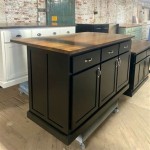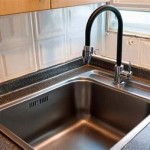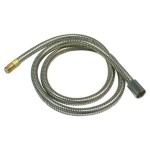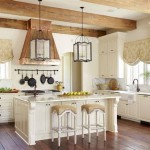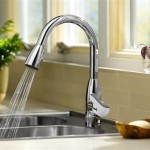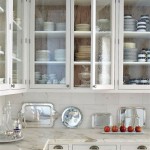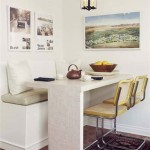Refaced Kitchen Cabinets Before And After: A Transformation Guide
Kitchen cabinets often serve as the focal point of the kitchen. They influence the overall aesthetic and functionality of the space. Over time, cabinets can become outdated, damaged, or simply no longer reflect the homeowner's style. Refacing kitchen cabinets presents a cost-effective and less disruptive alternative to complete cabinet replacement. This article explores the process of refacing kitchen cabinets, examining before-and-after transformations and offering insights into the benefits and considerations involved.
Refacing, at its core, involves replacing the existing cabinet doors and drawer fronts while keeping the existing cabinet boxes, or frames, intact. This process typically includes applying a new veneer to the exposed surfaces of the cabinet boxes to match the new doors and drawer fronts. Hardware, such as hinges, knobs, and pulls, are also typically replaced to complete the updated look. This contrasts sharply with a full kitchen remodel, which involves completely removing the old cabinets and installing new ones. Consequently, refacing can save significant time and money.
Understanding the Refacing Process
The refacing process begins with a thorough assessment of the existing cabinets. This includes inspecting the cabinet boxes for structural integrity. If the boxes are damaged, rotted, or severely out of square, refacing may not be a viable option. Minor repairs can sometimes be made, but extensive damage necessitates replacement. Assuming the cabinet boxes are sound, the next step involves selecting the new doors, drawer fronts, and veneer. A wide variety of materials, styles, and finishes are typically available, allowing for a high degree of customization.
Once the materials are selected, the existing doors and drawer fronts are removed. The exposed surfaces of the cabinet boxes are then prepared for the new veneer. This usually involves cleaning, sanding, and potentially priming the surfaces to ensure proper adhesion. The new veneer is then applied, carefully cut to size, and firmly bonded to the cabinet boxes. The new doors and drawer fronts are then installed, along with the new hardware. This meticulous process ensures a seamless and professional-looking transformation.
Preparation is a crucial aspect of a successful refacing project. The kitchen area should be properly protected to prevent damage to surrounding surfaces. This can involve covering countertops, appliances, and flooring with protective materials. The removal of existing doors and drawer fronts should be performed carefully to avoid damaging the cabinet boxes. Thorough cleaning and preparation of the cabinet box surfaces are essential for ensuring proper adhesion of the new veneer. Attention to detail throughout the preparation process contributes significantly to the final outcome.
The selection of materials for refacing plays a significant role in the overall aesthetic and durability of the finished product. Common materials for cabinet doors and drawer fronts include solid wood, wood veneer, laminate, and thermofoil. Solid wood offers a classic and durable option, but it can be more expensive than other materials. Wood veneer provides the look of solid wood at a lower cost, but it is important to choose a high-quality veneer to ensure longevity. Laminate is a cost-effective and durable option that is available in a wide range of colors and patterns. Thermofoil is a vinyl material that is heat-sealed to a fiberboard core, offering a seamless and easy-to-clean surface.
Veneer materials used for the cabinet boxes should match or complement the selected doors and drawer fronts. Wood veneer is a common choice for achieving a natural wood look, while laminate and other synthetic materials can be used to create a variety of different styles. The choice of veneer material should be based on the desired aesthetic, budget, and durability requirements. Proper installation of the veneer is critical to prevent peeling, bubbling, or other issues.
Analyzing Before and After Transformations
The transformative power of refacing kitchen cabinets is often best illustrated through before-and-after comparisons. Consider a kitchen with outdated oak cabinets featuring raised-panel doors and worn hardware. The "before" image depicts a dated and potentially drab space. Now envision that same kitchen after a refacing project. The old oak doors have been replaced with sleek, Shaker-style doors painted in a modern gray hue. The original brass hardware has been swapped for brushed nickel pulls. The cabinet boxes have been veneered to match the new door color. The "after" image showcases a bright, contemporary kitchen that feels significantly larger and more inviting.
Another example might involve laminate cabinets with a dated pattern. The "before" depicts a kitchen that feels tired and uninspired. The refacing project replaces the existing laminate doors with solid wood doors featuring a clean, minimalist design. A fresh coat of paint on the walls, combined with new countertops and backsplash, further enhances the transformation. The "after" image reveals a refreshed and updated kitchen that aligns with the homeowner's current style preferences. These examples demonstrate the dramatic impact that refacing can have on the overall look and feel of a kitchen.
Effective refacing goes beyond simply replacing doors and applying veneer. It involves careful consideration of the existing kitchen layout, color scheme, and overall design. The new cabinet doors and hardware should complement the existing elements and enhance the overall aesthetic. Thoughtful lighting can also play a crucial role in showcasing the refaced cabinets and creating a more inviting space. The choice of countertops, backsplash, and flooring should also be considered in relation to the refaced cabinets to create a cohesive and harmonious design.
The before-and-after transformation is not solely aesthetic. Refacing can also improve the functionality of the kitchen. New drawer slides can provide smoother operation and increased weight capacity. Soft-close hinges can prevent slamming and prolong the lifespan of the cabinets. Modifications can be made to the cabinet interiors to optimize storage space and improve organization. These functional improvements, combined with the aesthetic enhancements, contribute to a more enjoyable and efficient kitchen environment.
Key Benefits and Considerations
Refacing offers several advantages over complete cabinet replacement. Cost-effectiveness is a primary benefit, as refacing typically costs significantly less than replacing cabinets. The time required for refacing is also considerably shorter, minimizing disruption to the homeowner's daily life. Refacing is also a more environmentally friendly option, as it reduces the amount of waste generated by discarding old cabinets. Furthermore, refacing allows homeowners to retain the existing kitchen layout, avoiding the need for potentially costly and time-consuming structural modifications.
However, refacing is not without its limitations. As previously mentioned, the existing cabinet boxes must be in good structural condition for refacing to be a viable option. If the boxes are severely damaged or rotted, replacement is necessary. Refacing also does not allow for significant changes to the kitchen layout. If the homeowner desires a completely different configuration, cabinet replacement is the better choice. Furthermore, the selection of door styles and veneer options may be limited compared to the vast array of choices available with new cabinets.
The cost of refacing can vary depending on several factors, including the size of the kitchen, the materials selected, and the complexity of the project. Solid wood doors and high-end veneer materials will typically cost more than laminate or thermofoil options. Intricate door styles and custom finishes will also add to the overall cost. It is important to obtain multiple quotes from reputable contractors to compare prices and ensure that all costs are clearly outlined. Understanding the cost implications of different material choices and design options is essential for making informed decisions and staying within budget.
Selecting a qualified and experienced contractor is crucial for a successful refacing project. Look for contractors with a proven track record of quality workmanship and customer satisfaction. Check online reviews and ask for references from previous clients. A reputable contractor will provide a detailed estimate, clearly outlining the scope of work, materials to be used, and timeline for completion. They should also be able to answer any questions and address any concerns. A clear and open line of communication with the contractor is essential throughout the project.
The long-term durability and maintenance of refaced cabinets are important considerations. Proper care and maintenance can help to prolong the lifespan of the cabinets and keep them looking their best. Regularly cleaning the cabinets with a mild detergent and water can help to prevent the buildup of dirt and grime. Avoid using abrasive cleaners or harsh chemicals, as these can damage the finish. Promptly wiping up spills can prevent staining and water damage. Ensuring proper ventilation in the kitchen can also help to prevent moisture buildup and prolong the lifespan of the cabinets.

Kitchen Cabinet Refacing Review Why We Chose It For Our Home Kaitlin Madden

Kitchen Cabinet Refacing Makeover A Homeowner S Experience

Cabinet Refacing Process And Cost Compared To Painting

6 Kitchen Makeovers That Benefited From Refaced Cabinets

Refinishing Vs Kitchen Refacing American Wood Reface

8 Kitchen Cabinet Refacing Before And After Projects

Amazing Kitchen Refacing Transformations With Before After Photos Cabinets And

Amazing Kitchen Refacing Transformations

Refinishing Kitchen Cabinets Modern Refacing Made Easy Wisewood

How To Resurface Kitchen Cabinets 2024 Guide Forbes Home

